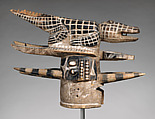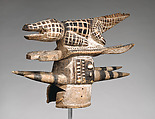Eku (crocodile) dance crest
This multitiered composition was likely commissioned by a young men’s association to be danced in funerary contexts. While the abstracted head of a bush cow forms its base, a more recognizable rendering of a crocodile extends the length of its summit. A powerful predator that moves between land and water, the crocodile is widely recognized throughout southeastern Nigeria as a metaphor for bridging worldly and spiritual realms. Idoma masquerade ensembles were composed entirely of fiber costume elements until increased interaction and exchange with neighboring Igbo and Cross River communities during the nineteenth century led to the introduction of wooden headdresses. Celebrated sculptor Oba of Otobi has enriched the surface of this example with both painted and incised designs.
During the 1950s, art historian Roy Sieber first documented Oba’s creative output of masks and shrine figures in the Lower Benue River region, which remained in use in the vicinity of Otukpu into the 1980s. Despite widespread recognition as a specialist carver, Oba likely relied on farming for his livelihood. He did not undergo a formal apprenticeship, but worked alongside and was influenced by a more senior sculptor, Ochai of Otobo. Together they transformed Otobi into a preeminent carving center. Works by Oba are also preserved in Nigeria’s Jos Museum and the Musée du Quai Branly in Paris.
This image cannot be enlarged, viewed at full screen, or downloaded.
This artwork is meant to be viewed from right to left. Scroll left to view more.




